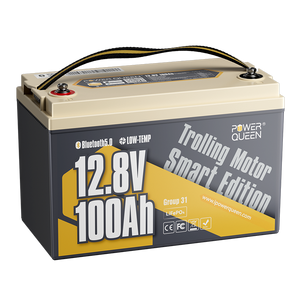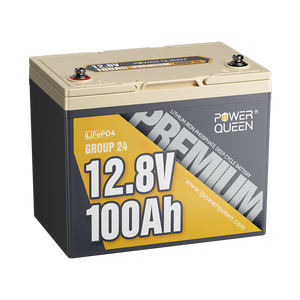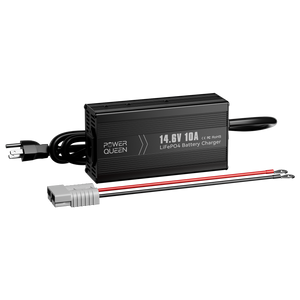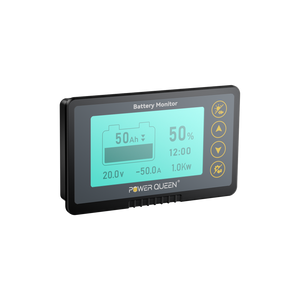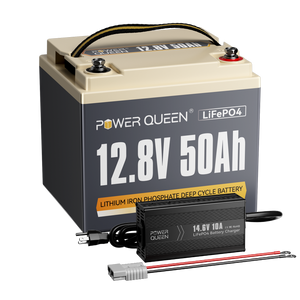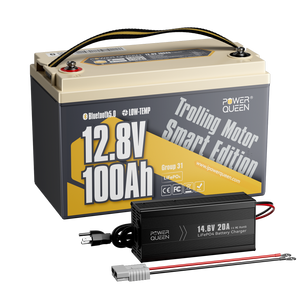The Ultimate Guide to Replace RV Battery
RVs are fantastic for traveling, camping or even as a tiny home on wheels. One of the most important parts of an RV is its battery, which serves as the source of power when you're off the grid or when there's a power outage. However, like any other battery, RV batteries wear out over time and require replacement. In this article, we'll discuss everything you need to know about replacing your RV battery.
Table of Content
- Part 1: Common Types of RV Batteries
- 1. Flooded Lead-Acid Batteries
- 2. AGM (Absorbent Glass Mat) Batteries
- 3. Gel Batteries
- 4. Lithium Iron Phosphate Batteries
- Part 2: 6 Signs that it’s Time to Replace Your RV Battery
- Part 3: How to Replace an RV Battery - Step by Step Guide
- Part 4: Benefits of Replacing Your RV Battery with a Lithium-ion Battery
Part 1: Common Types of RV Batteries
1. Flooded Lead-Acid Batteries
Flooded lead-acid batteries are one of the most common battery types used in RVs. These batteries come in various shapes and sizes to fit the needs of different vehicles and are known for their high charge rate and affordability. However, they require occasional maintenance by replenishing lost electrolytes with water, which can make them less convenient than other battery types. The lifespan of this type of battery is relatively short, with a cycle life of around 300-500. As a result, you will need to replace it after approximately three years of use.
Pros
- They are relatively low-cost compared to other battery technologies.
Cons
- Heavy and bulky: These batteries are heavy and bulky, which makes them difficult to install and handle.
- Require maintenance: Flooded lead-acid batteries require regular maintenance, including the addition of distilled water to replenish lost electrolytes, which can be inconvenient for some RV owners.
- Shorter lifespan: These batteries generally have a shorter lifespan than LiFePO4 batteries, so they will need to be replaced more frequently, adding to their long-term cost.
- Less efficient: Flooded lead-acid batteries are less efficient than LiFePO4 batteries, meaning they lose more energy as heat during charging and discharging.
- High Self-Discharge Rate: On average, a new and fully charged flooded lead-acid battery stored at room temperature (25°C or 77°F) can self-discharge between 3-20% per month.
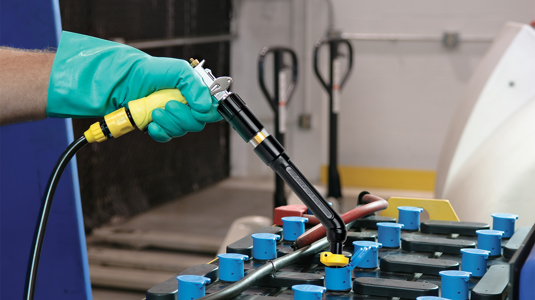
2. AGM (Absorbent Glass Mat) Batteries
AGM batteries are a great innovation in RV batteries because they can perform two functions - as a deep cycle battery and as a starting battery. They work by using fiberglass as a separator to hold electrolytes in place. AGM batteries are highly impact-resistant and have minimal internal resistance due to their tight packaging and ability to handle vibrations well. This low internal resistance reduces charging time and increases output voltage as power flows through the battery.
AGM batteries are also known for having no corrosion or acid leaks, making them arguably the easiest batteries to plug in and install with minimal maintenance.
Additionally, AGM batteries have a high reserve capacity and there are models designed for efficient solar energy storage applications, making them a great choice for off-grid use. With proper maintenance, AGM batteries can outlast three conventional lead-acid batteries, making them an ideal choice for RVs.
AGM batteries also have longer lifespan compared to flooded lead-acid batteries. With proper maintenance, an AGM battery can last up to 5-7 years or even longer.

Pros
- AGM batteries are maintenance-free and do not require regular watering or checking of electrolyte levels.
- They have minimal internal resistance, which means they can charge and discharge more efficiently and can deliver high bursts of power when needed.
- AGM batteries have a high reserve capacity, which means they can provide a consistent flow of power over an extended period.
- AGM batteries can perform both as a deep cycle and starting battery, making them versatile and suitable for a wide range of applications.
Cons
- They are sensitive to overcharging and require a specific charging profile, which makes them incompatible with some chargers.
- AGM batteries have a lower energy density than other battery types, which means they may not be suitable for applications that require a high amount of energy storage in a compact size.
- They are not designed for deep discharge cycling. Excessive deep discharge can shorten their lifespan, and they may not recover fully once discharged too deeply.
- AGM batteries may require a higher voltage charger to undergo a complete charging cycle.
3. Gel Batteries
Gel batteries are a type of RV battery that is valve-regulated and transforms into a gel-like substance when its electrolytes are mixed with sulphuric acid and silica. This gel substance enables the battery to function similarly to traditional lead-acid batteries, with one key difference being the addition of silica to create the gel mixture. Gel batteries are easy to install and maintain, and they require minimal attention due to their gel composition instead of liquid.
Pros
- Gel-cell batteries are sealed, which means they require less maintenance compared to lead-acid batteries.
- They have a lower self-discharge rate, which means they can be stored for longer periods without needing to be recharged.
Cons
- Gel-cell batteries are more expensive compared to lead-acid batteries.
- They have a lower energy density than lithium-ion batteries, which means they do not store as much energy.
- They can be damaged by overcharging or undercharging, which can shorten their lifespan.
- They require a specific charging voltage and current, which may require a specialized charger.

picture source: wikipedia.org
4. Lithium iron Phosphate Batteries
RV LiFePO4 batteries are lithium iron phosphate batteries specifically designed for use in recreational vehicles. These batteries are becoming increasingly popular among RV owners due to their many advantages over traditional lead-acid batteries.

One of the most significant advantages of RV LiFePO4 batteries is their high energy density, which allows them to store more energy in a smaller and lighter package. They are also highly efficient, with the ability to discharge and recharge at a faster rate than lead-acid batteries. Additionally, LiFePO4 batteries have a much longer lifespan compared to traditional lead-acid batteries, with some models lasting up to 10 years or more.
RV LiFePO4 batteries are also known for their safety features, including resistance to overheating and short-circuits. They are also environmentally friendly, with no toxic chemicals or heavy metals used in their construction.
Overall, RV LiFePO4 batteries are an excellent choice for anyone looking to upgrade their RV's power supply. They are efficient, durable, lightweight, and environmentally friendly, making them a great investment for any RV owner looking to travel off-grid without the worry of their power supply running low.
Learn more advantages of replacing RV batteries to LiFePO4.
Part 2: 6 Signs that it’s Time to Replace Your RV Battery
- If your check engine light turns on during driving and remains on while idling, it might indicate that your RV battery is not delivering sufficient voltage or has exhausted its power, which can affect your vehicle's performance and safety.
- Hearing sloshing or bubbling noises from your RV battery could mean that there's a leak in the battery's acid, which can corrode other metal parts of your vehicle and make it less safe to drive.
- If your RV battery is not charging or is charging slowly, it's time to replace it. Generally, replacing the battery every five years is a good practice.
- If the brightness of your headlights is reduced while driving, it's a telltale sign that your RV battery is wearing out and needs replacement.
- A bad smell emanating from your RV battery, such as a rotten egg, sulfur, or ammonia smell, could indicate a crack in the battery cell's casing, resulting in acid leakage and corrosion issues. This requires immediate attention and battery replacement.
- If you notice cracks, holes, or other damages on your RV battery, it's a sure sign of a replacement battery. Damaged batteries can leak acid, causing unsafe situations and potentially damaging surrounding components.
Part 3: How to Replace an RV Battery - Step by Step Guide
Step 1: Disconnect power: If you are replacing a household battery, you usually have a main circuit breaker that ensures all DC power to your devices is off. Turn this switch to the off position. If you do not have a main circuit breaker, turn off all individual breakers and switches that connect things like lights, refrigeration, and TV. If you're replacing a starter battery, turn off the engine. (Pulling the power wires from the battery while the equipment is running can damage the devices).
Step 2: Open the battery cover. Check your user manual to know the location of the household battery or starter battery. For safety reasons, it is recommended to wear safety goggles.
Step 3: First, remove the negative (black) cable terminal from the battery. For those stubborn wing nuts, this may require a socket wrench or pliers. If the nut is screwed too tightly, be careful not to strip it.
Step 4: Remove the positive (red) cable terminal from the battery. It is very important not to let the negative and positive cable terminals touch each other. More importantly, do not touch the terminals with your hands; if you touch both red and black at the same time, you will complete the circuit and no longer enjoy your RV.
Step 5: Carefully remove the battery from the battery box to avoid straining your back. It is recommended to seek help because household batteries are very heavy. Starter batteries are easier to operate with one hand.
Step 6: Replace the empty battery compartment with a brand-new battery.
Step 7: Connect the positive (red) cable terminal to the positive terminal post of the battery. Retighten the nut, being careful not to overtighten or strip the threads.
Step 8: Carefully replace the negative (black) cable terminal onto the negative terminal post of the battery. Retighten the nut as in step 7.
Step 9: Make sure the battery is secure and close the compartment.
Step 10: For your starter battery, once it's replaced, start the RV and go! For household batteries, turn the main circuit breaker to the on position and test your various breakers and switches to verify the power.
Note: For household batteries, if your RV comes with a voltmeter, test the battery's voltage. If the battery indicates more than 13 volts of DC voltage (VDC), then they are in good condition. You should replace batteries that cannot maintain more than 10-11VDC. If your battery indicates low voltage, try charging and retesting.
Watch the video to learn more
Part 4: Benefits of Replacing Your RV Battery with a Lithium-ion Battery
Replacing your RV battery with a Lithium Iron Phosphate (LiFePO4) battery can offer several benefits. Here are some of the advantages of using LiFePO4 batteries in your RV:
1. Higher energy density
LiFePO4 batteries have a higher energy density than traditional flooded lead-acid batteries, meaning they can store more energy in a smaller space. This makes them ideal for RVs with limited storage space. For instance, Power Queen 12.8V 100Ah’s energy density can up to 1280Wh while the same capacity lead-acid battery is approximately 35 Wh/kg.
![⚡[Final $179]⚡Power Queen 12V 100Ah Group 31 Deep Cycle Lithium Battery](//ipowerqueen.com/cdn/shop/files/111111111.png?crop=center&format=webp&v=1758323215&width=400)
![⚡[Final $179]⚡Power Queen 12V 100Ah Group 31 Deep Cycle Lithium Battery](http://ipowerqueen.com/cdn/shop/files/111111111.png?crop=center&format=webp&v=1758323215&width=400)

2. Longer lifespan
LiFePO4 batteries have a longer lifespan than lead-acid batteries and can last up to 10 years or more with proper maintenance. This means that you will not need to replace your RV battery as frequently.
3.Lighter weight
LiFePO4 batteries are significantly lighter than lead-acid batteries, making them easier to install and transport.

4.Faster charging time
LiFePO4 batteries can charge more quickly than lead-acid batteries, which means you can spend less time waiting for your battery to charge and more time enjoying your RV adventures.
5.No maintenance required
Unlike lead-acid batteries, LiFePO4 batteries do not require regular maintenance like topping off electrolyte levels, making them more convenient and less time-consuming.
6.Better performance in extreme temperatures
LiFePO4 batteries perform better than lead-acid batteries in extreme temperature conditions, including both hot and cold weather.
7.Safe
LiFePO4 batteries are considered safer than lead-acid batteries because they are less prone to thermal runaway and fires. Power Queen’s LiFePO4 batteries are also built with BMS to protect your safety.

8.Efficient
LiFePO4 batteries are more efficient than lead-acid batteries, meaning they lose less energy as heat during charging and discharging.
Conclusion
In conclusion, replacing your RV battery is an essential part of maintaining your vehicle's electrical system. Signs such as age, difficulty starting, dimming lights, and unusual noises can indicate that it's time to replace your RV battery. The process of replacing the battery is simple, but it's important to take safety precautions when doing so.
Finally, switching to a lithium-ion RV battery offers many benefits such as a lightweight and compact design, a longer lifespan, and minimal maintenance. So whether you're looking to upgrade your RV battery or replace a worn-out one, consider a lithium-ion battery for improved performance and efficiency.
Power Queen will always provide you trustworthy products and outstanding service. Feel free to contact service@ipowerqueen.com to ask your question.




